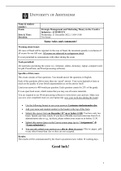Name & student
number:
Exam: Strategic Management and Marketing Theory in the Creative
Industries - 6314M0213Y
Date & Time: Wednesday, 21 December 2022, 11:00-13:00
Duration: Two hours
Some rules and comments!
Warning about fraud:
All cases of fraud will be reported. In the case of fraud, the maximum penalty is exclusion of
all exams for one full year. All exams are subjected to a plagiarism check.
It is not permitted to communicate with others during the exam.
Tools permitted:
All materials used during the course (i.e., literature, slides), dictionary, laptop, computer (only
for pdf, PowerPoint, and Word processing software).
Specifics of this exam:
This exam consists of four questions. You should answer the questions in English.
Each of the questions allows more than one “good” answer. Your score depends at least as
much on the quality of your (brief) argumentation as on the answer itself.
Limit your answer to 400 words per question. Each question counts for 25% of the grade.
It is an open book exam, which means that you may use all course materials.
You are required to use Word processing software to write down your answers. Make sure
you save your completed exam on your laptop (tip: save your work also during the exam).
• Use the following format to save your answers: Lastname-studentnumber.doc
• Add your name and student number to the header at the top of this form.
• Submit this answer form on December 21st on or before 13:00. You have only two
hours. Spend your time wisely. If you have officially received extra time from UvA
administration due to e.g., dyslexia, please submit your exam on or before 13:30.
• Submit this answer form via the Canvas course page (go to: “Assignments” à
“Exam submission”).
• You can only submit your answers as a .doc or .docx document. Files in .pages, .pdf,
or any other format than .doc or docx are not accepted.
Results:
The results will be communicated by the Onderwijsadministratie within 18 working days.
Good luck!
1
, Question 1 (max. 400 words; 25% of the grade)
Baum & Shipilov (2006) discuss the concept of "structural inertia" as well as the
different competitive strategies of generalists and specialists. Jia, Lewis & Negro
(2022) also discuss generalists and specialists, especially in the context of
collaborations between organizations
Discuss how the collaborations in Jia, Lewis & Negro (2022) could affect
structural inertia, and especially its consequences for innovative performance in
a rapidly changing environment, discussed in Baum & Shipilov (2006).
Jia, Lewis & Negro (2022) researched upon collaborations in the film industry and found that
collaborations between specialists and generalists lead to enhanced performance. Where
specialists tend to have an advantage over generalists in stable environments. However, on
the other hand generalists tend to have the advantage in changing envrionments. This is
explained by the Niche-width theory (Baum & Shipilov, 2006).
Baum and Shipilov (2006) describe how ecological approaches can explain why
organizations fail. One process is demographic processes, wherein structural inertia is
described. Structural inertia implies that when an organization grows and ages, it becomes
increasingly difficult to change the organization.
Jia, Lewis & Negro (2022) found that in uncertain environment, where consumers rapidly
can change preferences, and which is characterized as very competitive overall, the
collaborations between specialists and generalists are very beneficial as it increases
innovative performance and legitimacy, leading to better performance.
Thus, when a specialist is working together with a generalist it is likely to mitigate the
negative effects that structural inertia might bring for both parties. A negative effect of
structural inertia is that the firm fails to sustain performance in a changing environment due
to its inadaptability. Especially the specialist will benefit from a collaboration with a
generalist as this type of firm is disadvantaged in a changing environment, as explained by
the Niche-width theory (Baum & Shipilov, 2006)
By working with a generalist, it will be less likely the case that the specialist will fail as they
will be able to perform innovatively, even in a changing environment.
256 words
Question 2 (max. 400 words; 25% of the grade)
Simon (1991) discusses markets and organizations. Fayard, Stigliani & Bechky
(2017) discuss "nascent occupations". Consider a "nascent occupation" (in other
words, all the professionals who "belong" to that nascent occupation) as if it
were an organization and discuss at least one characteristic mentioned in Simon
(1991) that is applicable to the situation of a nascent occuption, discussed in
Fayard et al. (2017).
Fayard et al. (2017) empirically test how Service designers distinguished themselves from the
2




